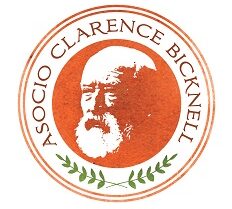In 2022 the Bicknell family, with the support of Graham Avery, published an art reproduction of this exceptional work by Clarence Bicknell, and it is available for purchase on Amazon and at www.clarencebicknell.com/shop. Clarence mentioned his Book of Guests in Esperanto in a description that he wrote of the Casa Fontanalba: “The walls are painted with Laburnum & dandelion and there is a deep dado with the initials of all the different people who have slept in the house. There have been about 110 up to this point. A short biography with these initials is written in Esperanto in a book for the information of posterity.”
Clarence created the contents for a dozen vellum-bound albums, of which this one, The Book of Guests in Esperanto, has a smaller format than the others. In this book, from 1906 to 1918, he wrote descriptions in Esperanto of selected visitors on the left page and painted watercolours of flowers on the right. Individuals range from friends, family, botanists and archaeologists to family dogs (Leo, Capi, and Clarence’s much loved Mahdi). The page for Emile Cartailhac shows how proud Clarence was that this eminent archaeologist visited the rock engravings of the Val Fontanalba. Cartailhac’s initials ‘E.C.’ are illuminated with features from the rock art including the plough and oxen.” The illuminated initials, many of them related to the individual, are striking and charming features of Clarence’s work.
This little book is a reminder of Clarence’s artistic talent, his wide range of friends and visitors, and a colourful and entertaining tribute to the language and the hope that Esperanto represents.
Buy the Book of Guests in Esperanto at www.clarencebicknell.com/shop or on Amazon print-on-demand worldwide
Many interesting aspects of the people named in the book were collated during the transcription and translations. They were to numerous to add to the book itself so we give them here where researchers can access them with web search…
- Two start dates for the book are given on page 1. Clarence did not start writing the book until 1910 but the visitors are those who came already in the past since 1906 when the house was built.
- Some small errors of spelling in Clarence’s Esperanto have been left in the transcription.
- Clarence writes Mellville and we have corrected the spelling to Mellville; he is clearly identified in his books like A Manual of Venereal Diseases by officers of the Royal Army Medical Corps, 1907, edited by Lieut. Colonel C. H. Melville, Secretary of the Army Medical Advisory Board, see https://iiif.wellcomecollection.org/pdf/b21933467 and Military Hygiene and Sanitation: A Retrospect, 1926, by Colonel C. H. Melville, C.M.G., M.B., late R.A.M.C., see https://journals.sagepub.com/doi/abs/10.1177/146642402604700109.
- In the original Esperanto text of Clarence, abbreviated words like ‘Sro’/’Srino’ (‘Mr.’/’Mrs.’) are often written with an underlined superscript (‘Sro’/’Srino’). In the transcribed ESP version these are usually, but not always, simplified to ‘Sro’/’Srino’. We have systematically simplified all such abbreviations in the Esperanto version.
- The prefixes ‘Sro/Srino’ need to be translated appropriately in the other languages. In the existing text this is done in a quite haphazard way, so we adopted the following rule: the other language versions should use the prefix appropriate for the person’s nationality or language, i.e. Mr./Mrs., Sig./Sig.ra, M./Mme. This is already the case, for example, in entry 40, where ‘Sro Berry’ is translated as ‘Mr. Berry’ in all three language versions, but it is not always the case.
- Several entries are not in the hand of Clarence and we have made mention of this in the transcipts. They were most likely done by Mercede Pollini, who was a good Esperantist, after Clarence’s death.
